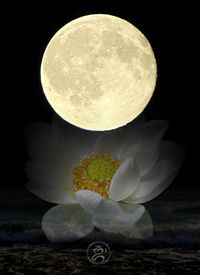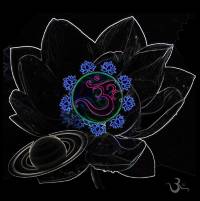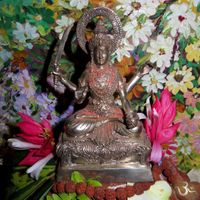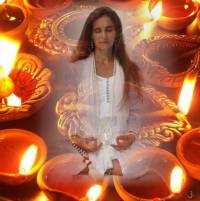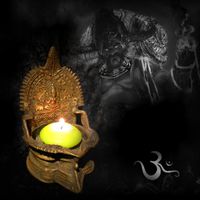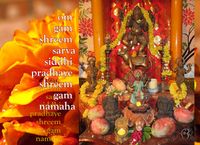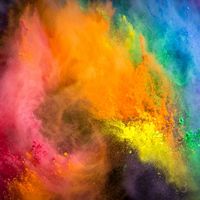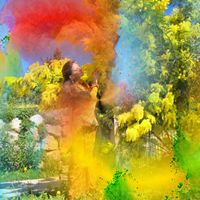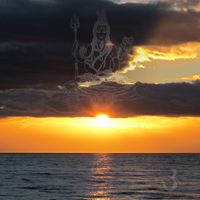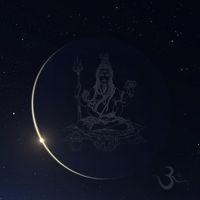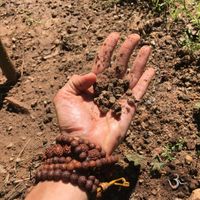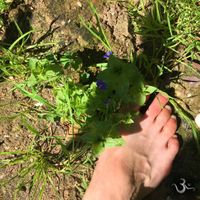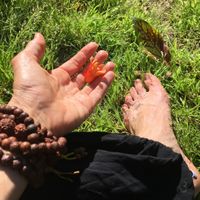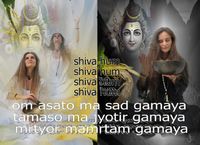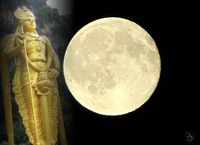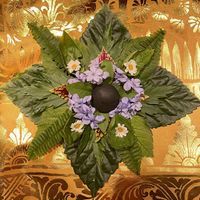Purnama - Full Moon
When I was on the beach with my little fur sweetheart “Mowgli” tonight, I looked up at the sky. It was already dark and the sky was also overcast. But there was such a glimmer of light. Suddenly the veils dissolved for a moment and I could see the full moon. I looked with grateful eyes into this soft light of harmony. Waves came to the beach. And for a moment I felt transported to my beloved island of Bali. In Bali the full moon is called "Purnama" and our house used to be in the "Jalan Pantai Purnama", the street (Jalan) that led to the "Full Moon (Purnama) Beach (Pantai)". I remembered that the full moon day has special importance for the Balinese. In Bali, it's all about balance, harmony and peace. The Balinese live in a “lotus world”. They pray not only to the gods but also to the demons. So they do not exclude darkness from their lives. Light and shadow form a harmonious whole. This is also reflected in their art, in their dances and simple in their lives resisting. It is an acceptance of light and dark, joy and sorrow, benevolence and malice. Sometimes everything is brightly lit, sometimes everything is dark. “Purnama” means full moon, but "Purnama" also means complete, infinite and perfect (in Sanskrit “Purna”). I love to look into the light of the moon. Unlike the sun, the moonlight is gentle and harmonious. It is a transformed light. In the light of the moon lies magic and somehow I feel the light of the moon as a kind of blessing. The same is true of the Balinese. The moon goddess Dewi Ratih gives the living beings on earth light in the darkness. She reminds the Balinese that it is not dark in us but bright. Our very own light of the soul.
Every full moon day is honored by the Balinese people, by making offerings of fruits, cakes and flowers, dressing appropriately, visiting their local temple, reciting mantras and scriptures, as well as prayers, rituals and meditations. The connection of the Balinese with the spiritual world, the gods, demons and ancestors is very, very strong, so that they create their offerings with the utmost attention to detail and a loving spirit of gratitude not only on full moon days, but every day! I was very inspired by them and followed this tradition for a long time. Through the connection to my beloved Guruji Osho I let go of all traditions, but after I became "empty" and heard my inner voice, I know that the Balinese and Hindu worlds are mine. Since then, I'm tinkering again. Now, I do not call this an offering, but a "gratitude gift". So, tonight I honor the completeness of the moon and all the life here on earth.
I was still looking up into the light, into the healing light of the moon in the night sky. More and more waves rolled onto the beach, dissolved again in the sea. I almost sang "There is so much magnificence near the Ocean, waves are coming in, waves are coming in" because that described that moment perfectly. But the Vedic Purnam mantra came softly from my lips...
Oṁ pūrṇam adaḥ pūrṇam idaṁ pūrṇāt pūrṇam udacyate.
Pūrṇasya pūrṇam ādāya pūrṇam evāvaśiṣyate.
Oṁ. Śāntiḥ śāntiḥ śāntiḥ.
Om, That (Outer World) is Purna (Full with Divine Consciousness);
This (Inner World) is also Purna (Full with Divine Consciousness);
From Purna comes Purna (From the Fullness of Divine Consciousness the World is manifested) ,
Taking Purna from Purna, Purna Indeed Remains
(Because Divine Consciousness is Non-Dual and Infinite).
Om Peace, Peace, Peace.
And my beloved Guruji Osho explains this mantra once as follow:
“Om Purnam is one of the most significant statements ever made anywhere on the earth at any time. It contains the whole secret of the mystic approach towards life. This small sutra contains the essence of the Upanishadic vision. Neither before nor afterwards has the vision been transcended; it still remains the Everest of human consciousness. And there seems to be no possibility of going beyond it. The Upanishadic vision is that the universe is a totality, indivisible; it is an organic whole. The parts are not separate, we are all existing in a togetherness: the trees, the mountains, the people, the birds, the stars, howsoever far away they may appear – don’t be deceived by the appearance – they are all interlinked, all bridged. Even the smallest blade of grass is connected to the farthest star, and it is as significant as the greatest sun. Nothing is insignificant, nothing is smaller than anything else. The part represents the whole just as the seed contains the whole.” ~ OSHO
The sea rushed, clouds moved in front of the light of the moon and I was back in the present. Here and now, and ran “light-filled” with Mowgli down the beach into the darkness ...
And since then the day for me means "moonless-silence"! Mahalaya Amavasya, the Day of Lunar Stillness, is the day on which I express my gratitude to all previous generations of people who have contributed to my life. That's how I learned and adopted it from the Hindus, because I feel that it's very beautiful. So many generations have lived before me and I owe all of them how I live today. Let's not always look at the bad. Everyone makes mistakes, even our generation. But we can learn from the mistakes. Let's start very small with ourselves and in our environment. I am grateful for everything that others have created for me. There are languages with which I can communicate, houses offer me protection. How many people have tested my food, whether you can eat it at all? These are just a few examples. Nothing is self-evident in my opinion. Everything is a gift and for that I am grateful. Not just today, actually every day. There are only a few exceptions. But of course they exist. I'm not enlightened!!! The Hindus have special rites that they practice today and in the days before. These include donating food to poor people, fasting, spiritual practices, and reciting mantras. It was originally also a day off. I am not for imitation. For me, it's important that something happens out of my heart and that's how I express my gratitude. Just be thankful, in your own way.
For me, the "moonless silence" is a good day to make new spiritual resolutions. It's a day to empty myself, so I have room for the Divine. It's a day to start something new.
The day of the "moonless-silence" is always on other days of the week. On Saturday, it's called "Mahalaya Amavasya Shani". Shani is Saturn and this is a planet that is also associated with darkness in astrology. Many people fear and anxiety. After two years of own darkness, I know that just this darkness has allowed me to grow spiritually. I am very thankful and appreciate this period of life. Shani is a guru who has put my way of life to the test. Now I am ready for the light.
Sharad Navratri, the festival of the Divine Femal Energy!
Om Dum Durgayai Namaha
Navdurga (nine Durgas) is the name for the nine phases of life of the goddess Parvathi. Parvathi lived through each phase in a different form. These are now venerated during the festive season. Every day a different form, a different avatar, its characteristics and its benefits are celebrated. The ten-day festival culminates with Dussehra or Vijaya Dashami.
In 2021 I really celebrated the festival for the first time and shared my experience about it with my Gayatri Sangha. You can find my posts on a separate page. Click the photo.
next Sharad Navratri: 2022, 26th September - 05th October
Happy Dipavali! Happy Deewali! India is turning into a sea of lights. Light, symbol of the good, hope and a new beginning after a dark time. At Dipavali there are many pujas for different gods , but mainly it is the festival for Lakshmi, the goddess of happiness, love, fertility, prosperity, health and beauty. Lakshmi donates not only wealth, but also spiritual well-being, harmony and abundance. Lakshmi is also the protector of plants, that's how I see her with my "Balinese soul", because without plants there is nothing else! But Lakshmi cannot work unless my beloved Ganesha is worshiped beforehand. And so on Dipavali, in addition to Lakshmi, Ganesha is welcomed into the houses. And there is a wonderful mantra for that, the Lakshmi Ganesha mantra.
ॐ गम श्रीम सर्व सिद्धि प्राधाये श्रीम गम नमः
OM GAM SHREEM SARVA SIDDHI PRADHAYE SHREEM GAM NAMAHA
The mantra stands for knowledge, focus, wealth, educational success, intelligence, sharp mind, good luck, prosperity, success, scholarship, mind powers and spirituality. This Mantra removes all the obstacles from the path of success. It removes each and every enemy from the devotee’s life. It ensured clarity of thoughts and judgement.
Recite the mantra with devotion and love. It is a relatively short mantra and so it will certainly not be difficult for you to recite several cycles (108x = 1 cycle). It should be at least two and preferably in the morning at Sandhya time (the auspicious, energetic time before sunrise). Why twice? I didn't get an answer for that, but I could imagine, one for Lakshmi and one for Ganesha, one for the feminine aspect, one for the masculine aspect, one for wealth (Lakshmi) and one for wisdom (Ganesha). Both are representations of peace, prosperity and wisdom. Both are incomplete without one another.
"The earthern
lamp of ego
is the only darkness.
Blow out this lamp and see:
That which remains,
that alone is unearthly.
That alone is consciousness."
(Osho wrote this message in Hindi is the 1979s)
next Divali: 2023, November, 12th
HOLI,
the Indian "festival of spring", the "festival of colours" or the "festival of love".
Osho says, “When Holi comes, and we sing and dance, breaking all bounds and throwing off our normal codes of conduct. On that day, we throw all our morality, rules and etiquette to the winds; for one day our river flows, breaking all disciplines. But do you think that a river that flows for one day of the year is going to reach the ocean? And even this one day is only an apology for the real flowing; it is just a mockery of our real selves!” And he continues, “Look at nature: there is Existence enjoying Holi every day, and celebrating Diwali daily. In nature the colors flow afresh every day, new flowers open each morning. Even before the old leaves fall, the new buds are bursting out and the new shoots are springing up. The festival does not stop even for a moment – it is non-stop, every moment is Holi or Diwali. Such will be the life of a religious person. He will be festive each moment – he is grateful that he is. His every breath is an expression of gratitude and benediction.”
Holi is one of the oldest festivals in India. On this day, all barriers by caste, gender, age and social status seem to be removed. It is celebrated boisterously and you sprinkle and throw each other with colored water and colored powder, the gulal. The color powder originally came from certain flowers, roots and herbs that have a healing effect. Today synthetic colors are often used. Of course, they are no longer healing, but harmful. Nevertheless, the colors are still consecrated on the altar in the sacred sense in the evening before Holi.
Like most Indian festivals, Holi has a religious background. The Holi Festival has its origins in the Hindu sagas of Prahlad and Holika. Prahlad was born the son of the demon Hiranyakashyap, but developed into a staunch believer in the god Narayana. This was a thorn in his father's side and so he sent his sister Holika to kill Prahlad. Holika has a sari that protects her from fire. So she set herself on fire after her nephew Prahlad took a seat on her lap. Her plan failed because, according to legend, she was unaware that the sari could only protect her if she came into contact with fire alone. But not with someone. To complete the victory of good over evil, Lord Shiva saved Prahlad from the flames as a reward for his faith.
Like all festivals, Holi is very complex in its meaning. In the spiritual realm, as can be seen in the associated mythology, it conveys the message of the triumph of good over evil. In nature, on the other hand, it marks the victory of spring over winter, because the festival begins with the blossoming of nature. The reconciliation aspect is also an important point for people, because it means that old disputes should also be buried these days.
Therefore, the ceremony begins the evening before the color festival. In many places, large fires are lit, pyre burned to celebrate the defeat of evil. The next day is all about colors, celebrations and friends. People roam the city and visit friends and relatives. The most important thing: everyone really throws everyone with colorful paint or water balloons filled with colored water!
“Bura na maano, Holi Hai!”
This is a mythological story about it, but the most attractive aspect of Holi is the licensciousness it gives to people to celebrate their lower instincts, to cathart and express whatever is suppressed in their unconscious, without feeling guilty. Osho once said: The Holi festival is just a catharsis for the whole country to throw out all nonsense. It is good, it cleanses. More days are needed because more nonsense is there. One Holi is not enough. In fact, every month a day for Holi is needed.
So why do we only celebrate Holi once a year? Every day is a festival day. Every morning we bloom anew, equipped with all the colors of existence. Let's drop old things to make room for new things. Let’s flow, flow to the ocean. Let’s not always take everything so seriously. Let us free ourselves. Let's just live consciously, responsible for ourselves!
next Holi Festival: between 2023, March 8th
SOMA PRADOSHRAM
a very auspicious day to meditate and be aware of all what you do
On this day a spiritual time window opens, which is called Pradosh Vrat in India. Pradosh Vrat is synonymous with something dark or late evening. When it gets dark, this is also a good time to meditate. When it gets dark it is also a good time to reflect on the divine. During the day the mind likes to go outside, but at night it is easier for it to go inside. In between you can perceive the divine everywhere. If you are active during the day then see the divine on the outside. When it is night see the divine within. Sunrise and sunset are two very magical moments, because in these phases you can see the divine outside and inside at the same time. Pradosham has three different energy levels, depending on which day of the month they occur. Each energy level indicates how much karma can be released at that time. The smallest energy level occurs every day 1-2 hours before and after sunset. The average energy level of Pradosham occurs twice a month - on the 13th lunar day after the new moon and after the full moon. Pradosham's greater energy level occurs when one of the 13th lunar days occurs on a Saturday. But tonight it's a little easier for you to bring light into your life. Pradosham is, so to speak, a gift from the universe to accelerate your spiritual growth and make your life easier and happier. Think about how the poisons of life, for example anger, jealousy, attachment and self-centeredness, destroy your joy and also (world) peace. Use the time to just go inside. Stay hOMe! Go to your very own hOMe! Shiva is worshiped at Pradosham. Shiva is a symbol of the divine. Shiva is a symbol of change. Birth, preservation destruction. Destruction of the illusions we put in our heads. Shiva is the infinite awareness that dwells in each of us. Don't forget: We are part of the whole!
I love to sing this very special Shiva Mantra:
“Shiva HUM, Shiva HUM, Shiva HUM, Shiva HUM
Shiva HUM Pavanang, Shiva HUM Salilang
Shiva HUM Dharati, Shiva HUM Akshang
Shiva Sarvatrang, Shiva Sarvasyang
Mahakale Shiva Jivan Mulang
Namo Namami Shiva, Namao Namami Shiva
Sattya Sundare Shiva, Bhava Bhaya Harenang
Vishva Rupa Shiva, Prane Prakashang
Namo Namami Shiva, Namo Namami Shiva”
“Through the vibration of “Shiva HUM” air, water, earth and space shall be consecrated. Shiva is omnipresent and all pervading. Shiva is the great power of redemption and renewal, the base of all living. I prostrate in respect before Shiva. Shiva is truth and beauty, removes the anxiety caused by the temporal existence. His cosmic form is also the light of life. Worship to Shiva!” ~ Mohani Heitel
At Pradosham /Pradosh Vrat before Newmoon also begins the time when you can best connect with nature. Become aware that you are part of nature. Nature and you are constantly connected with each other in an exchange. The time between Pradosham and the new moon (I always call the lunar silence this night) is particularly conducive to this experience. The moon's gravity creates a certain level of inertia on these days, and your body and energies are much more connected to the earth than on other days because it pulls them in that direction. Go barefoot through nature! Sit under a tree. Breathe. Touch nature with your hands. Let earth trickle through your hands. Eat in nature. If you can't go outside because of the lock down, go barefoot anyway. For example, imagine that your floor is a forest floor, a dirt road, or a beach. Maybe you have plants at home. Make a prayer with the plant. Not with words, but through a soul connection.
I like to wear black around the “lunar silence”. Black is an absorbent color. The spiritual energy that I now experience in the next few days in connection with (Shiva) nature is transmitted even more intensively. But be careful with negative energy; this is transmitted in the same way for black.
Enjoy it, energy and awareness!
Shiva HUM!
Masik Shivaratri
The darkest night of a month is called Masik Shivaratri. The monthly Shivaratri! The time around lunar stillness favors the stability of our lower mind and allows in this way access to the higher mental state of pure perception, which can extend and connect our consciousness to the universal mind (Shiva) and making it possible to experience as a result the essential truth behind any event in our life.
The lower mind is the concrete mind, which focuses on logic, reason and fact. It is never in the present, but always in the past and future. The lower mind is the representation of our ego. Because of the ego we are limited and are separate from universal power and truth. When we are born, we are still pure and unbiased. The ego arises with education, through our desires and idols. The ego is not our original self. The lower mind houses also negative thoughts and emotions. This is the part of the mind that knows no matter how difficult the situation is, we are loved, worthy and continuously protected and guided by the divine and God. This is the part inspired by beauty, vulnerable emotions, aspirations, ideals and archetypes.
The higher mind represents the pure knowledge and the divine in us. It gives us creative power and innovative solutions. It doesn't matter how something works or arises. Only the moment is important. No reaction, but a situation-related behavior without thinking about the past or the future. The higher mind surpasses ego, transcends boundaries and holds universal truths. It is the gateway to our soul and intuition.
Shivaratri means, “Shiva” (cosmic mind) and “Vrat” (fast). Shivaratri is a good time to come back to yourself. Forgo all unnecessary things. Fast, if only in small batches. Meditate. And let a prayer arise from it. Your very own prayer. Be yourself a gift for the universe.
I like to sing these mantras on Shivaratri. It is not the usual "Om Namaha Shivaya", but for me it reflects the meaning of the day.
om asatoma sad gamaya
tamaso ma jyotir gamaya
mrtyor mamrtam gamaya
The "Asatoma" mantra comes from the Brhadaranyaka Upanishad). It means:
Lead me from the asat(untruth) to the sat (truth).
Lead me from darkness to light.
Lead me from death to immortality
“Shiva HUM” means the redeeming power of the Divine, but it is more a vibration)
THAI PUSAM FESTIVAL
Full moon - this is auspicious in itself, but the full moon in the Tamil month of Thai is a very auspicious day with a significant Hindu festival. I experienced this festival in 1994 and it was the most impressive thing I had ever seen in my life. More than that, I was part of the celebrations, right in the middle, for three days and three nights. I will never forget the smell of fire and camphor, as well as the incessantly chanted prayers and mantras, the courage but sometimes the weakness of the devotees. I will never forget the eyes of the devotees.
On the one hand, the festival commemorates the birthday of Lord Murugan (Skanda), the youngest son of Shiva and Parvati. He is the brother of my beloved Ganesha. On the other hand, the festival commemorates the handing over of a lance from Parvati to Murugan so that he might defeat the demon (Rakshasa) Surapadman. The myth says: During the struggle between the demons and the heavenly devas (gods), the devas were always defeated, unable to withstand the forces of the underworld. In desperation they turned to Shiva, imploring him to provide them with a capable leader under whose heroic leadership they might yet win victory. The merciful God granted their wish by creating the mighty, divine warrior Murugan (Skanda). He took control of the heavenly forces and defeated the demons...
to continue, please click on the photo
Shraddha
Two weeks before the great Navratri festival, Hindus commemorate their ancestors. Shraddha is performed for two weeks and culminates with the Ekadashi fast and the Amavasya ceremony. Shraddha is a ritual that should be performed with true awareness; it is a ceremony for the ancestors, especially for the deceased parents. Shraddha is a way for people to express their heartfelt gratitude and gratitude to their parents and ancestors. Our parents gave us life. They have helped us find our way in the world, even if that may not have gone so well in some families, but basically parents only do what is best for their children; the best they can give themselves, financially, morally and spiritually. Parents who have not experienced love cannot pass it on either. So it is also a celebration of compassion, forgiveness, love. With Shraddha one prays for the peace of mind of the ancestors.
I am not a Brahmin and so I never perform a ceremony in a traditional and prescribed way, but with love, devotion and awareness. I think of my ancestors, who I was allowed to experience, especially my grandmothers and my father. I bring them flowers, make them happy with playing music on my Babu drums, gongs and singing bowls. I give them food, light, fire and fragrance. I chant mantras and be connected to them. Yes, with all my love, with all my heart.
Om Namo Bhagavate Vasudevaya
This mantra is called Mantra of salvation and is considered as a spiritual formula for attaining salvation.
Om — Om is a Brahminic and cosmic sound.
Namo — Salutation and Obeisance.
Bhagavate — powerful, compassionate and who is divine.
Vasudevaya — Vaasu means: life and god in all creatures means: God It means that God (life / light) is the life of all creatures.
Maybe I could inspire you!
INDIRA EKADASHI SHRADDHA - A VERY AUSPICIOUS DAY TO PRAY FOR THE ANCESTORS
”OM Namo Bhagavate Vasudevaya”
“Om and salutations to the divine One who dwells in all.”
Ekadashi, the eleventh day after the fullmoon. Ekadashi is particularly suitable for fasting, meditation and contemplation. Ekadashi takes place twice a month, once after the new moon and once after the full moon. Ekadashi after the “lunar silence” (new moon) is in the bright half of the month, which is called "Shukla Paksha" in Hinduism. Shukla Paksha is the phase of the waxing moon. Shukla Paksha is considered to be more suitable than Krishna Paksha, the phase of the waning moon. Krishna Paksha is namely the dark phase. Shukla Paksha is generally beneficial for anything that needs to grow. Krishna Paksha is favorable to everything that is to become less. So if you want to clean up, want to part with the old, if you want to focus on the essentials, then Krishna Paksha is particularly important and beneficial for it. Ekadashi is especially important to the people in India who worship Vishnu or Krishna. Ekadashi is considered a special holiday there. Ekadashi is advised to fast ideally. If you can't fast on Ekadashi, at least give up something. Eat something simple. For example, just eat fruit or drink a smoothie. But much more important than giving up is that you meditate more intensively on this day, sing mantra or live in a yogic way.
Indira Ekadashi Shraddha is a very special Ekadashi, it is considered to give salvation after death and therefore, devotees observe fast on this day of their ancestors. The Indira Ekadashi Vrat is considered to be the most sacred and holy of all the Ekadashi fasts. Fasting of Indira Ekadashi is associated with liberation of ancestors and peace of their souls. By keeping this fast, Vishnu liberates sentient beings. On this day those who worship Vishnu can receive his blessings and their ancestors can rest in paradise. At the same time, worshipers can attain immense happiness and prosperity in their lives. They fast for a day to please Vishnu and seek his blessings. Also, it is very important to read the sacred scriptures about Vishnu along with fasting rituals and worship. Thereby one can attain peace in the three worlds, bhur bhuvah svaha.
On Indira Ekadashi Shraddha flowers will be laid in the form of a sacred swastika. I will lay the flowers and leaves as a mandala, with the swastika I have a queasy feeling because of the European past. Before praying to Vishnu, do not forget to invoke Ganesha, otherwise the day and the ceremony will not go well! Vishnu is mostly worshiped at home as a shaligram, a sacred stone collected from riverbed of the Kali Gandaki, a tributary of the Gandaki River in Nepal. They are typically fossils of ammonite shells (400 to 66 million years old). Or pray in front of a Vishnu or Krsna Murthi/image. Do a small ceremony with lights, incense, water, food-offering and mantras. Also place a light in front of a Tulsi plant, for Vishnu lives in it, is it.
”OM Namo Bhagavate Vasudevaya” -
“Om and salutations to the divine One who dwells in all.”
MORE SOON...

